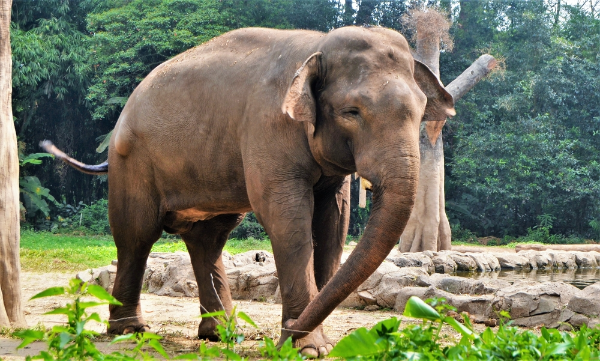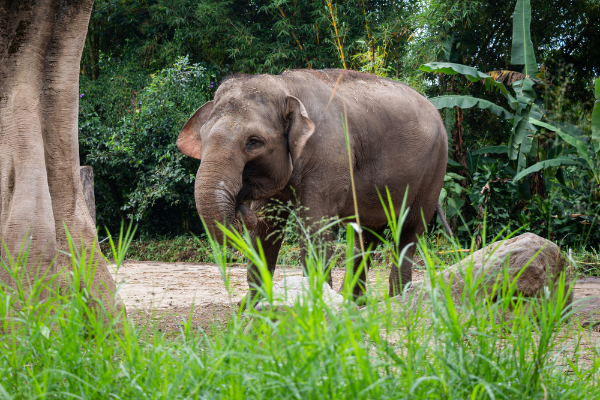Sumatran elephants are critically endangered, with around 2,400 remaining in the wild. The biggest threat to their survival is habitat loss, as forest is cleared for plantations and development. These gentle giants are also targeted by poachers, who kill them for their ivory tusks. There are several things we can all do to help protect these amazing creatures. Learn more about Sumatran elephants and what you can do to help save them!

Sumatran Elephant Description
Sumatran elephants are the smallest of the Asian elephants. They have been classified as endangered since 2008 due to habitat loss and fragmentation. Sumatran elephants are clever and quick-witted, with a high level of intelligence. Like other elephants, they are social creatures and live in close-knit herds led by a matriarch. Sumatran elephants are forest-dwellers, and their diet consists mainly of plants and fruit. The Sumatran elephant is an important part of the Sumatran ecosystem, and its loss would have a devastating impact on the local environment. Sumatran elephants play a key role in seed dispersal, which helps to keep the forest healthy and diverse. They also help to maintain the forest canopy by eating leaves and branches. In addition, Sumatran elephants play an important role in controlling local insect populations. By [eating insects], they help to keep the insect population in balance, which benefits both the local ecosystem and human residents. The Sumatran elephant is an essential part of the Sumatran forest ecosystem, and its loss would be devastating to the local environment.
Sumatran Elephant Habitat
Sumatran elephants are a subspecies of Asian elephant that is native to the island of Sumatra in Indonesia. These elephants are the smallest subspecies of Asian elephant, and they are also the most critically endangered. There are estimated to be less than 2,000 Sumatran elephants left in the wild, and their habitat is disappearing rapidly due to deforestation. As a result, Sumatran elephants are classified as endangered by the International Union for Conservation of Nature (IUCN).
Sumatran elephants once lived throughout the island of Sumatra, but they are now confined to just a few pockets of forest. The loss of habitat is the biggest threat to Sumatran elephants, and it is caused by a variety of factors including deforestation, conversion of forest to farmland, and illegal logging. Sumatra has lost more than 50% of itsForest cover in the last 50 years, and at current rates of deforestation, it is estimated that all Sumatran forest will be gone within 20 years. This would be devastating for Sumatran elephants as they rely on Forest for their food and shelter.
Sumatran Elephant Diet
Sumatran elephants are one of the most endangered species of elephants in the world. These gentle giants are only found on the island of Sumatra, in Indonesia. Sumatran elephants are forest elephants, which means that their diet consists primarily of foliage, bark, and roots. In order to get the nutrients they need, Sumatran elephants must eat large quantities of vegetation each day. Unfortunately, the loss of habitat due to deforestation is one of the biggest threats to Sumatran elephants. As their habitat disappears, so does their food source. In addition, Sumatran elephants are often killed for their ivory tusks or for meat. As a result, the Sumatran elephant population is in decline. Without intervention, these majestic animals may disappear entirely from the wild.

Sumatran Elephant Size
Sumatran elephants are the smallest subspecies of elephant. They are found only on the Indonesian island of Sumatra, and there are an estimated 2,400 to 2,800 left in the wild. Sumatran elephants grow to be about 2.5 to 3.0 meters (8.2 to 9.8 feet) at the shoulder and weigh between two and four metric tons (4,400 to 8,800 pounds). Male Sumatran elephants are larger than females and can reach weights of up to six metric tons (13,200 pounds). Sumatran elephants are endangered due to habitat loss and conflict with humans. Sumatra is a heavily forested Island and as it gets deforested for palm oil plantations Elephants come into Human settlements in search of food which leads to Human-Elephant Conflict. Currently, there are several conservation efforts underway to protect Sumatran elephants and their habitat. One such effort is the Sumatran Elephant Conservation Strategy, which was developed by the Indonesian Ministry of Forestry in collaboration with international experts. The strategy includes plans for managing human-elephant conflict, protecting elephant habitat, and increasing public awareness about the importance of conserving this threatened species.
Sumatran Elephant Lifespan
Sumatran elephants are a subspecies of Asian elephant that is native to the island of Sumatra. Sumatran elephants are the smallest subspecies of Asian elephant, and they are also the most critically endangered. The Sumatran elephant population has declined by 80% over the past 75 years, and there are now only an estimated 2,400 Sumatran elephants remaining in the wild. The primary threats to Sumatran elephants are habitat loss and conflict with humans. Sumatran elephants have a lifespan of 60-70 years in the wild. However, due to the decline in population, the average lifespan of Sumatran elephants is expected to decrease in the future.
Sumatran Elephant Behavior
Sumatran elephants are some of the most interesting and unique creatures on the planet. Though they are closely related to Asian elephants, they have several distinct characteristics that set them apart. For instance, Sumatran elephants are the only elephants in the world that have five toes on each foot. They also have a higher body temperature than other elephants, and they are more resistant to disease.
Sumatran elephants are also known for their gentle nature. In contrast to African elephants, which can be quite aggressive, Sumatran elephants rarely show aggression towards humans or other animals. This peaceful behavior has made them a popular tourist attraction in their native Sumatra, and it has helped to ensure their survival in the face of habitat loss and other threats.
With only an estimated 2,400 Sumatran elephants left in the wild, it is clear that this species is in danger of becoming extinct. Though they are protected by law, their numbers continue to decline due to poaching and habitat loss. As a result, it is important for us to learn as much as we can about these amazing creatures in order to ensure their future survival.
Sumatran Elephant Speed
Sumatran elephants are the smallest elephants in the world, and they are also the fastest, capable of reaching speeds of up to 25 miles per hour. These animals are found only on the Indonesian island of Sumatra, and they are critically endangered, with an estimated population of just 2,400 individuals. Sumatran elephants are threatened by habitat loss and fragmentation due to human activity, and they are also often victimized by illegal poaching. Sumatran elephants play an important role in their ecosystem, dispersing seeds and helping to shape the forest landscape. Thanks to their speed and agility, these animals are able to outrun most predators. However, they are no match for humans, and the illegal ivory trade continues to take a toll on Sumatran elephant populations.
Sumatran Elephant Hunting
Sumatran elephants are some of the most magnificent creatures on earth standing up to ten feet tall at the shoulder and weighing in at around two thousand pounds, they are the largest land mammals in Asia. But these gentle giants are facing a grave threat: Sumatran elephants are being hunted for their ivory tusks. Every year, hundreds of elephants are killed for their tusks, which are then sold on the black market. The Sumatran elephant population has declined sharply as a result, and the species is now classified as “Critically Endangered” by the International Union for Conservation of Nature. Hunting Sumatran elephants is not only cruel, but it is also illegal. These majestic animals deserve our protection, not our exploitation.
Conclusion
Sumatran elephants are critically endangered and their populations continue to decline. The Wildlife Conservation Society is working tirelessly to protect these animals, but they need your help. If you want to make a difference for the future of these majestic creatures, consider making a donation to WCS today. With your support, we can ensure that Sumatran elephants will be around for generations to come.
Frequently Asked Question

